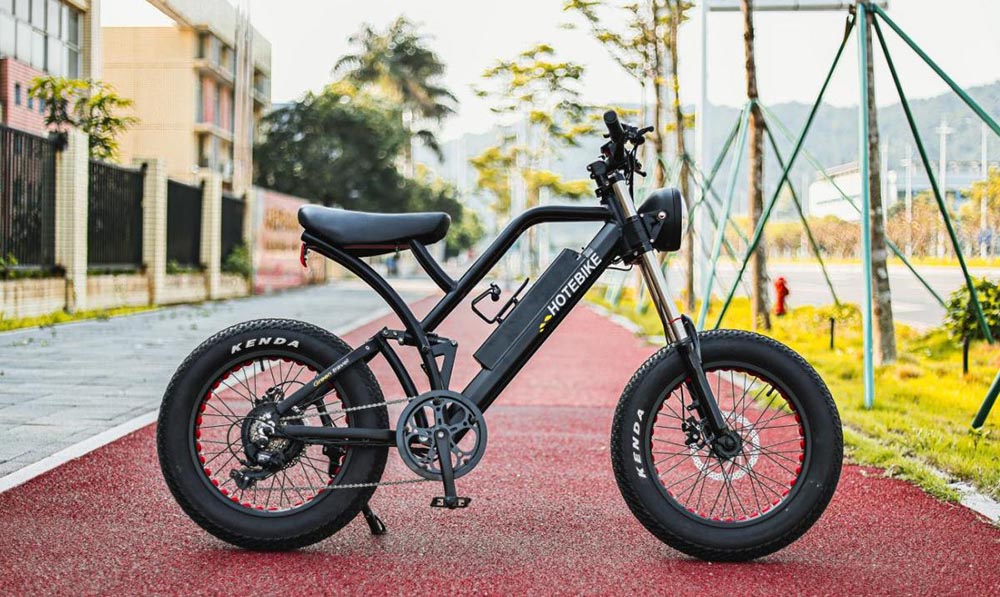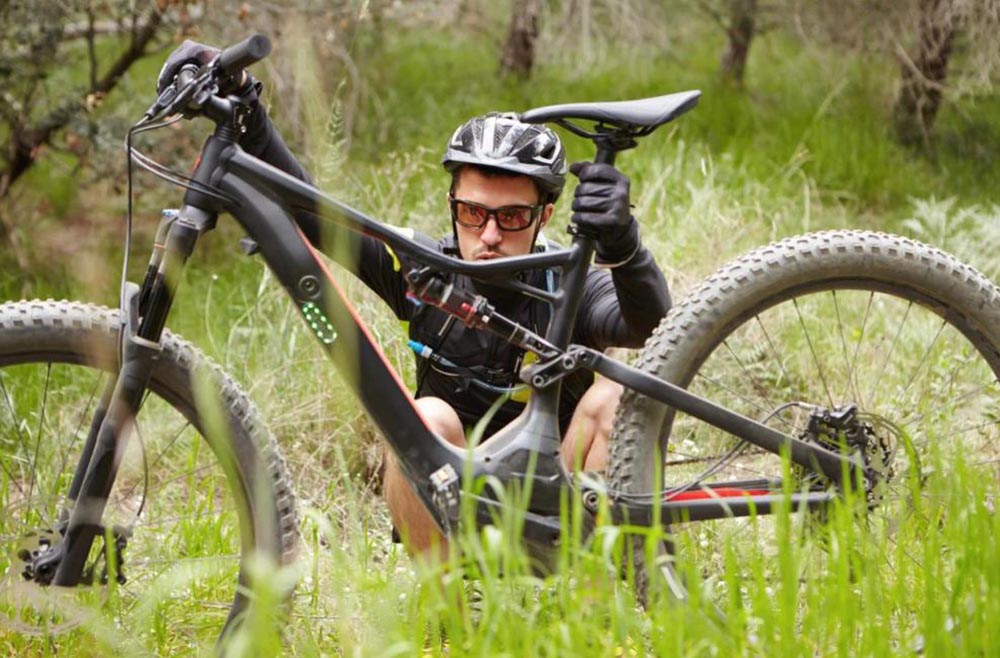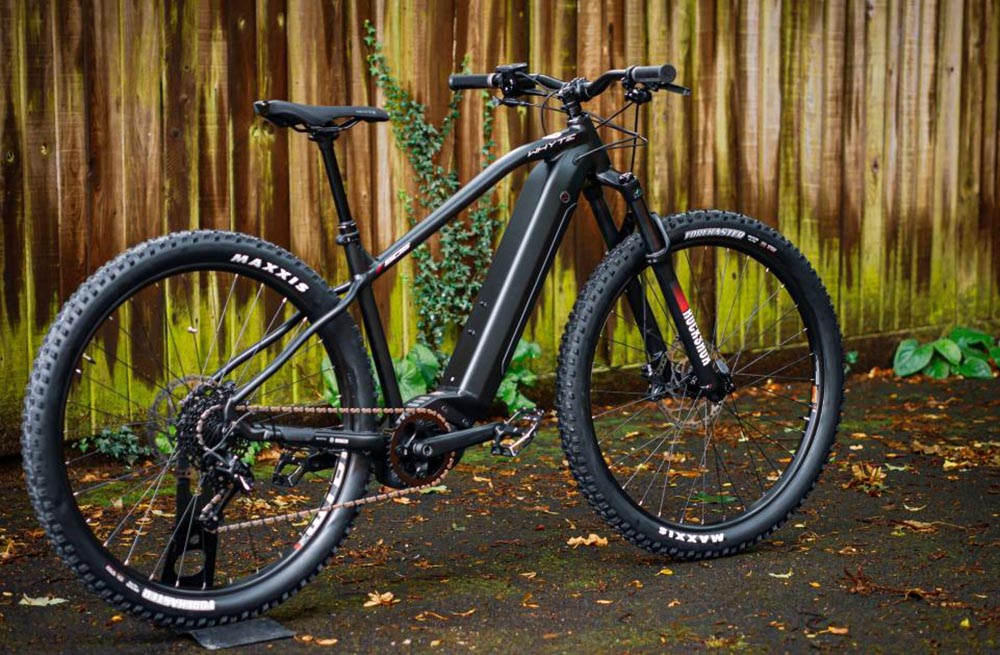Full Suspension eBike & Hardtail eBike
What is a Full-Suspension E-Bike?
When it comes to electric mountain bikes, you’ll come across those with front wheel suspension, rear suspension, full suspension and more. Knowing the difference between these types of electric bikes and the difference they’ll make in your riding experience is important to make sure you get the best e-bike for your needs. Here, we break down the basics about electric bikes and suspension.

In the most basic terms, a bike’s suspension is something that “suspends” you from feeling every little (or big!) bump in the road. It makes the ride smoother and more comfortable and is typically built into bikes made for off-road adventures, like mountain bikes.
Some e-bikes are designed with suspension only in the front (sometimes referred to as hardtail bikes). Others (though not many) have suspension only in the rear. Those with both front and rear suspension are referred to as full suspension electric bikes.
While it might seem like the more the suspension, the better, that’s not always the case. Which is best for you depends on who you are as well as how and where you want to ride.
For some novices, the suspension is still a vague concept, so what is suspension? Suspension forks are accessories installed on many ebikes, especially mountain bikes and road bikes. To ensure the personal safety and riding experience of cyclists on bumpy roads and to reduce damage to cycling equipment such as ebikes, suspension forks are indispensable: in some cases, there is no suspension fork, and only tires, frames, and the rider’s limb joints are used to buffer the bumps of the road, or the improper use of suspension, stiffness, damping, and other parameters far deviate from the normal values, which will break the riding experience, damage the equipment and interfere with the operation, and then threaten the rider’s safety.
The suspension also can be subdivided. According to the classification of elastic media, bike suspension fork can be divided into two types: spring type and pneumatic type. As the name suggests, spring suspension relies on compressed springs to generate spring force, and pneumatic suspension relies on compressed air to create force, but the pneumatic suspension is not an equivalent substitute for spring suspension. The main advantage of the pneumatic suspension is its light weight. Because there is no spring, its weight will be relatively light, so its price is almost double that of the spring suspension of the same grade. At the same time, the spring suspension we recommended is not only affordable but also has its unique advantages. Some mountain bikes cost several thousand dollars, and road bikes are not equipped with a pneumatic front fork but an “oil spring fork,” a spring used as an elastic medium. The suspension fork with oil is the damping medium because it is believed that the spring is more sensitive to rebound than the air pressure. After we learn about the suspension system, we will have a new understanding of ebike’s suspension. The suspension of an ebike is the most basic requirement of an electric bicycle, and it is also a direct factor to ensure the rider’s comfortable riding.
As mentioned earlier, hardtail bikes have only a suspension fork, while full-shock bikes have a front fork and a rear shock, the type of suspension on a mountain bike can affect the bike’s control, traction, and comfort. It is related to your riding experience directly.
Who needs a full-suspension e-mountain bike?
Do you prefer trails that can get rough or maybe have some technical sections? Roots, stones, challenging passages are your thing? Do you plan to go on alpine tours as well? Then you should go for a full-suspension e-MTB. But even if you are a mountain biker, who wishes for more comfort, your choice can be a full-suspension e-bike.
Furthermore, if you ride a full-suspension E-MTB you will get more traction, and with their low centre, they are well-balanced. That’s how full-suspension e-mountain bikes will provide safety and allow the rider to go fast. The more travel your e-bike offers, the greater the reserves will be.
If you choose a full-suspension e-mountain bike out of comfort reasons you will relive your body of shocks. And thanks to a powerful e-drive, you can climb even the steepest ascents.

What is a Hardtail Ebike?
A hardtail is a mountain bike that usually features a front suspension fork, but no rear suspension – giving them a rigid, unsuspended frame. Known for their lighter weight and lower price point, hardtail bikes are a popular choice for new off-roaders.
Hardtail ebike
Advantages:
- Better force – because the shock will release force when active force is applied;
- More responsive control – because the control is also active;
- Less prone to breakage – fewer moving parts, fewer stressed and worn parts;
- Fewer parts in the car – which means it is lighter.
Disadvantages:
However, a hard car is dependent on the rider’s ability and skill to ride on unsmooth ground terrain, and of course, there are limits to show your recycling skill, especially at high speeds because it is not easy to deal with rapidly changing ground conditions.

Full suspension ebike
Advantages:
There is a shock absorption system – at high speeds it is less likely to be thrown away by road protrusions, or tripped over by depressions.
Simply put, it is more capable off-road. Shock absorbers are used to deal with uneven ground, the worse the ground. A hardtail with a front shock enhances pedaling efficiency to a certain extent, because most of the force acts on the rear wheel, and no shock on the rear wheel will bring much higher pedaling efficiency.
Disadvantages:
However, any cycling action will be unloaded, including pedaling, or more active ones; The longer the shock, the softer the force will be released; the ebike will be heavier.
Full suspension ebikes are inevitably heavier, but in rough terrain, shocks are a great advantage. The increased traction when climbing prevents the rear wheel from slipping, allowing more pedaling power to be converted into forward momentum. It can be faster and more comfortable on rough descents, and can reduce fatigue on long rides.
When you’re deciding between a hardtail and a full suspension mountain bike, there is no ‘better’ or ‘worse’ option. But what you can find is the bike that’s best for your specific needs as a rider – whether you are a seasoned rider or a complete beginner.
With a full suspension mountain bike, you get the added comfort, the faster downhills, and the unbelievably easy ride on even the most technical terrain. With a hardtail you get lower-priced options, lighter frames and better battery efficiency.
So, it all comes down to – what kind of rider are you and where do you want to ride?
Buy a full-suspension ebike if:
You’re willing to spend more: excellent quality entry-level full-suspension mountain bikes start around $2,000. It could be a good choice if you would like to spend that price (or more), and the full-suspension function makes a lot of help for your special terrain riding.
You ride mostly technical trails: If you love riding in nature, and riding down winding trails and accelerating over rough gravel is your pursuit, then a full-suspension mountain bike is suitable. Full suspension bikes are built for some specific type of terrain; the combination of front and rear suspension creates a smoother ride with better traction and control, which translates to more fun riding experience.
You want a more comfortable ride: A full-suspension mountain bike absorbs most of the shock that would be transmitted to your body (in some cases, will buck you off the bike). This helps reduce fatigue so you can ride faster, longer, and more comfortably.
You need speed: The front and rear suspensions are so good at soaking up bumps that you can often carry more speed than a hardtail on technical trails.
Buy hardtail ebike when:
You have a budget: If you are a beginner and when your budget is set at $1,500 or less. You can try hardtail, and this is because hardtails are simpler in design and less expensive to manufacture, which allows bike manufacturers to use similarly priced but high-end components (such as derailleurs, shifters, brakes, etc.).
You spend most of your time riding on flat trails: If you spend most of your time on flat trails, a hardtail ebike can provide you with a fast and fun ride, with its front suspension front forks soak up moderate bumps.
You want to reduce the maintenance fee : Hardtail bikes are simpler and less expensive to maintain with fewer moving parts than full-suspension bikes. Of course, some basic maintenance is still required.
You want a light ebike: Hardtail bikes are generally lighter than full-suspension bikes because of their simpler design and fewer parts.
Which type of mountain ebike is right for you? The answer largely depends on how much you’re willing to spend and the terrain you like to ride on, but there are other factors. The short answer is: if you’re willing to spend a little more and you’re looking for professional mountain biking, buy a full-suspension ebike. On the other hand, buy a hardtail bike if you are a novice on a tight budget and spend a lot of time riding on flatter roads.
Sign up for our email list and be entered to win a Pioneer Electric Bike
 Shuangye ebike
Shuangye ebike
